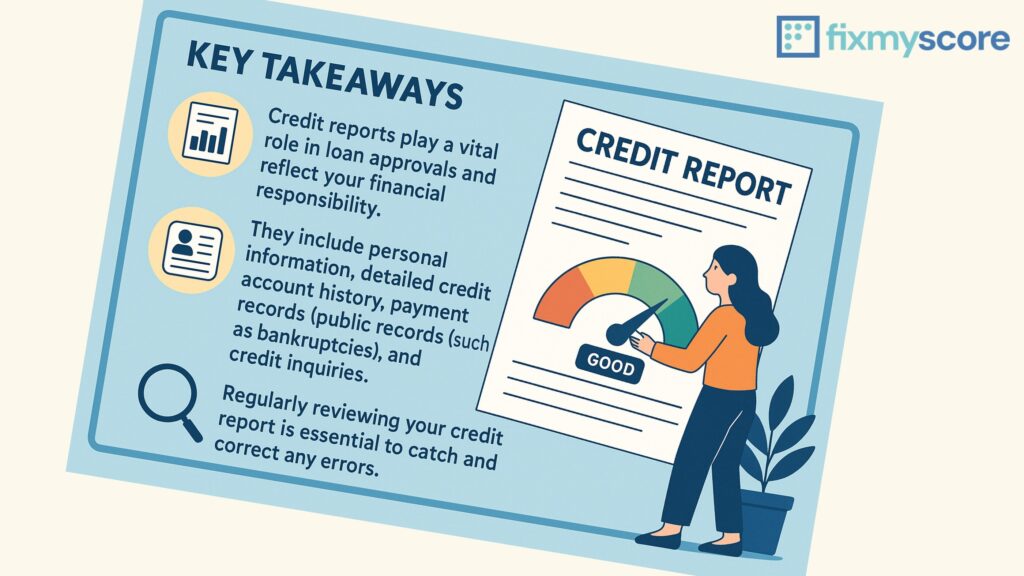Let’s be honest—credit reports can look like a confusing puzzle of numbers, terms, and abbreviations. But here’s the good news: with the right breakdown, you can quickly learn what matters most and take control of your financial future. This simple guide will walk you through everything you need to know—without the jargon.
What Exactly Is a Credit Report?
Think of your credit report as your financial report card. It is a detailed summary of how you’ve handled borrowed money over the years. Every time you make a credit card payment, take out a loan, or miss a payment, it is recorded here.Lenders use this information to decide whether to approve your application for a new loan or credit card, and what interest rate to offer. The better your report looks, the better deals you’ll receive. That’s why understanding your credit report is so important.

What’s Inside a Credit Report?
Let’s break down the major sections of a credit report and what each one tells lenders about you:
1. Personal Information
This section is straightforward. It includes your name, current and previous addresses, date of birth, and Social Security number. While this data doesn’t impact your credit score, it is important to check for accuracy—errors here can lead to confusion or even identity mix-ups.
2. Credit Accounts (The Heart of Your Report)
This section lists your current and past credit accounts, such as credit cards, car loans, mortgages, and personal loans. It shows when you opened each account, your credit limit or loan amount, current balance, account status, and payment history.
It offers lenders a comprehensive view of how you manage credit, and it is also where you can spot accounts that don’t belong to you.
3. Payment History
Your payment history is the single most important factor in determining your credit score. This section reveals whether you pay bills on time, how often you’re late, and whether any accounts have gone to collections.
Even one missed payment can remain on your report for up to seven years. But don’t panic—a few old late payments aren’t the end of the world. Lenders tend to focus more on recent payment behavior.
4. Public Records
This section shows any bankruptcies, unpaid taxes (tax liens), or court-ordered debts. Fortunately, most people will find this section empty.
If public records do appear, they can seriously harm your credit score. For example, a bankruptcy can remain on your report for up to 10 years, so it is worth avoiding at all costs.
5. Credit Inquiries
Whenever you apply for credit, a lender performs a “hard inquiry” that slightly lowers your score. These inquiries stay on your report for two years.
Too many inquiries in a short time can make you appear desperate for credit, which raises red flags. On the other hand, “soft inquiries”—like checking your own credit—don’t impact your score.
How This Breakdown Can Help Improve Your Credit Score
Now that you understand your credit report, here’s how to focus on the factors that directly influence your score—and how to improve them:
1. Payment History (35%)
Timely payments are crucial. Consistently paying your bills on time shows lenders you’re reliable. To avoid missing due dates, consider setting up automatic payments or reminders.
2. Credit Utilization (30%)
This is the amount of credit you’re using compared to your total credit limit. To maintain a healthy score, aim to use less than 30% of your available credit, and ideally under 10% for the best results.
3. Length of Credit History (15%)
The longer your credit history, the better. Keeping your oldest credit cards open—even if you rarely use them—helps build a stronger, more stable credit profile.
4. New Credit Applications (10%)
Each new credit application results in a hard inquiry. Apply for new credit only when necessary to avoid lowering your score.
5. Credit Mix (10%)
Having a variety of credit types—such as credit cards, auto loans, and mortgages—can positively impact your score by showing you can handle different forms of debt.
Also Read: Good Credit Habits to Build Financial Freedom
Final Words
Don’t let credit reports intimidate you. With this straightforward guide, you now have the knowledge to take charge of your credit health. The sooner you start monitoring and improving your credit, the sooner you will unlock better interest rates and more financial opportunities.

Key Takeaways
- Credit reports play a vital role in loan approvals and reflect your financial responsibility.
- They include personal information, detailed credit account history, payment records, public records (such as bankruptcies), and credit inquiries.
- Regularly reviewing your credit report is essential to catch and correct any errors.
- FixMyScore provides tailored financial solutions designed to help you take control of your credit health and improve your financial standing.
Credit Report Breakdown: FAQs
Q1: What is a credit report, and why is it important?
A credit report is a detailed record of your credit history compiled by credit bureaus. It includes information like your credit accounts, payment history, credit inquiries, and public records such as bankruptcies. This report is used by lenders to assess your financial reliability. If you’re overwhelmed by credit reports, understanding what’s in yours is the first step toward regaining control of your financial health.
Q2: How often should I check my credit report?
You should check your credit report at least once a year from the major credit bureaus. However, many experts recommend reviewing it more frequently to catch errors or signs of identity theft early. If you feel overwhelmed by credit reports, scheduling regular reviews can simplify the process and make it less daunting over time.
Q3: What information is included in my credit report?
Your credit report includes:
- Personal information (name, address, SSN)
- Credit account history (loans, credit cards, payment behavior)
- Credit inquiries (soft and hard pulls)
- Public records (judgments, liens, bankruptcies)
If you find inaccuracies in any of these areas, the best way to dispute a credit report online is by visiting the official websites of the credit bureaus, where you can file a dispute quickly and track the resolution.
Q4: Does checking my own credit report hurt my credit score?
No, checking your own credit report is considered a soft inquiry and does not affect your credit score. It is actually a healthy financial habit.
Q5: What’s the difference between a credit report and a credit score?
Your credit report is a comprehensive history of your credit activity, while your credit score is a numerical representation of that report, usually ranging from 300 to 850. The score helps lenders quickly assess your creditworthiness. If you’re unsure why your score is low, reviewing your report can give you insights.




[…] Credit reports can be overwhelming, but they don’t have to be. Overwhelmed by Credit Reports? Here’s a Simple Breakdown. […]
Can you be more specific about the content of your article? After reading it, I still have some doubts. Hope you can help me. https://www.binance.com/register?ref=IHJUI7TF